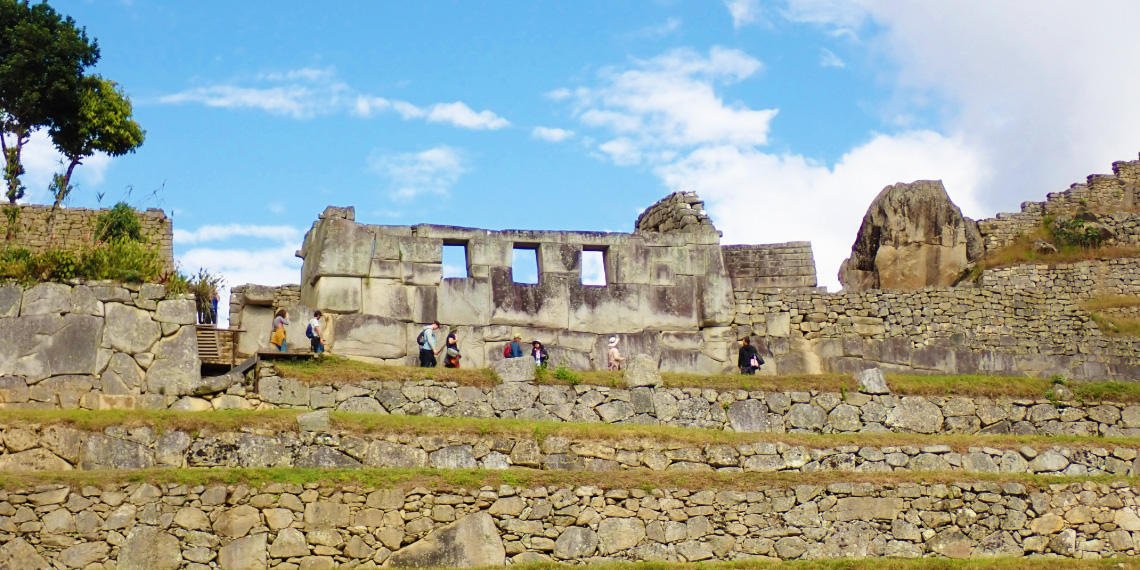Circuit 3 of Machu Picchu: Witness the Wonder

Circuit 3 is tailored for those seeking a more relaxed exploration of this ancient city.
Here are some highlights from this circuit:
- Terraces of the Ceremonial Rock: Just beyond the entrance, these expansive terraces offer a stunning view of the ceremonial rock. The rock itself is a vital piece of the site’s spiritual puzzle, often used by the Inca for rituals and as a sundial to mark the solstices.
- Funerary Stone Group: As you proceed, you’ll come across an intriguing area believed to be used for funerary rituals. The meticulously carved stones here reflect the Inca’s intricate workmanship and their spiritual connection to the earth.
- Temple of the Sun: One of the only round buildings in Machu Picchu, the Temple of the Sun is an architectural marvel. This temple is aligned astronomically, with windows positioned to capture the first rays of the sun during the winter solstice, illuminating the interior in a celestial spectacle.
- Royal Tomb: Below the Temple of the Sun, this enigmatic cave-like construction is thought to have served as the final resting place for nobility. The fine stonework suggests its significant status, making it a must-see for history enthusiasts.
- Principal Temple: This temple’s three-sided construction offers insights into Inca religious practices and architecture. Although slightly damaged by time, the temple still stands as a testament to the durability of Inca construction.
- Sacred Plaza: This area provides a serene environment where it’s easy to imagine the bustling activity of Inca priests and nobility. Surrounded by several important structures, including the Principal Temple, it served as a focal point for ceremonies.
- Intihuatana Stone: A highlight of Circuit 3, this carved stone pillar, known as the “hitching post of the sun,” is an ancient astronomical clock or calendar. It’s a profound symbol of the Inca’s connection to the cosmos, and touching it was believed to imbue one with the spirit of the sun.
- Central Square: The heart of Machu Picchu, this large, open square was likely a communal area used for gatherings and social activities. Its spacious layout accommodates large groups, making it a perfect spot to pause and enjoy the panoramic views of the surrounding mountains.
- The Condor Temple: An artistic representation of a condor, this temple features a large rock carved to resemble the bird’s wings, with a small cave underneath symbolizing its body. This site is thought to have been used for ceremonies related to the afterlife, highlighting the Inca’s deep spiritual beliefs.
Climb. Conquer. Cherish

Climb Your Way to Wonder

The agricultural section of Machu Picchu.
These terraces carved into the mountainside provided flat land for cultivation, preventing soil erosion and maximizing the arable area. These terraces were used to grow various crops essential to the Inca diet, including maize, potatoes, and quinoa.
Rise Above the Ordinary

Where Every Peak Tells a Story

The Scared Plaza. This open area is located at one of the highest points in the city, surrounded by important religious structures, including the Main Temple and the Temple of the Three Windows. The Sacred Plaza is thought to have been a communal gathering space used for significant ceremonies and religious festivals. Its elevated position offers a commanding view of the entire city and the lush Urubamba Valley below.
Soaring Spirits, Sacred Stones

Beyond the Clouds, Beneath the Stars

Marvels Set in Stone



One of the most striking and symbolic structures within Machu Picchu is the Temple of the Condor. Here, a large naturally occurring rock forms the head of a condor, with carved rocks creating the wings. Below the wing-like formations is a small cave, which is believed to have been used where sacrifices may have been held before rituals.
Conquer More Than Just Mountains

The Dry Moat is a unique feature of Machu Picchu’s defensive architecture. It separates the outer urban sector from the inner sacred sector, which includes key religious and ceremonial buildings. This moat, unlike traditional water-filled moats, is simply a deep, wide trench filled with earth and stones.
Machu Picchu: Reach New Heights

The Granite Quarry. This area on the southern edge of the city is where the Incas extracted the stones that make up the city’s structures. Unfinished blocks and partially carved stones still litter the site, offering a glimpse into the stone-working techniques of the Incas.
Touch the Sky, Embrace History

Heights of Happiness, Mountains of Memories

